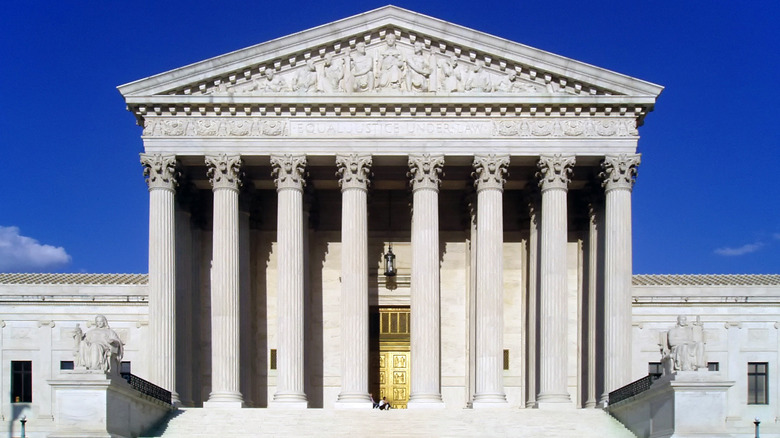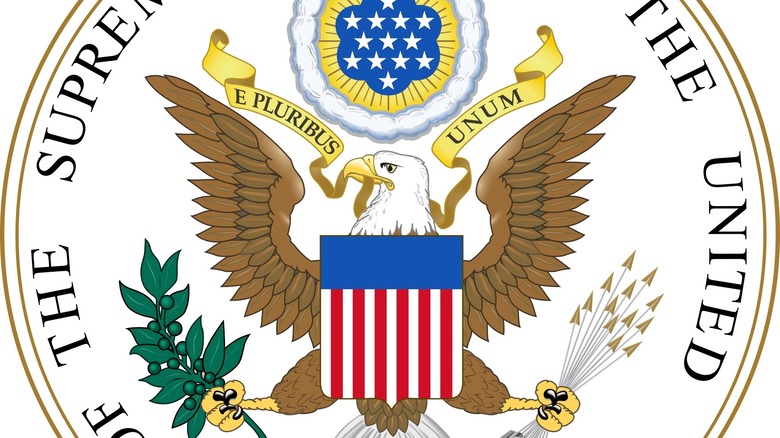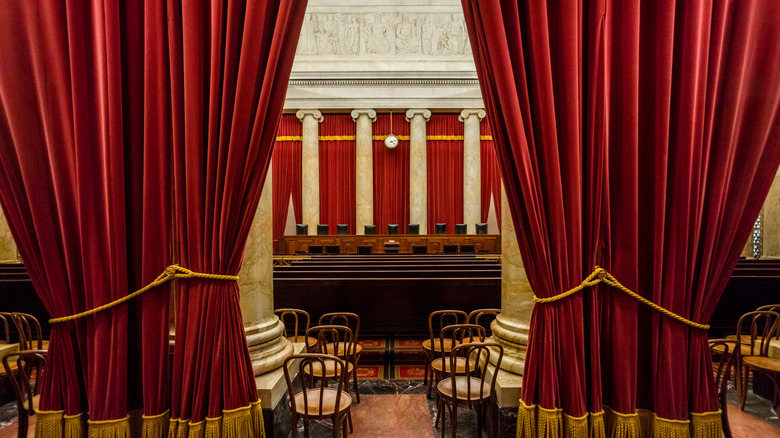The Story Behind The Supreme Court Official Seal
Supreme Court Justice Clarence Thomas' recent discharge from the hospital for "flulike" symptoms (via the New York Times) has sparked a bit of curiosity amongst the public regarding the highest court of the land. For example, how many Supreme Court Justices are there again? Nine. Which justice is the oldest? Stephen G. Beyer from San Francisco. Do they sit in a specific order? Yes, by seniority (via the Supreme Court website). Most pertinently, do they have a secret clubhouse handshake? Not really — it's just a normal handshake.
In any case, such questions point to the supremely traditional, ritualistic nature of the court. By and large, the Supreme Court is saturated not merely with case briefs, transcriptions, and documents awaiting signatures, but traditions stemming back to the court's first sitting in 1790. It's steeped in so many that one historian has dubbed it "the first Court still sitting."
Case in point: the Supreme Court's official seal. Governmental seals operate much like government officials themselves: you know you've seen a bunch, you can maybe recognize a couple ,but can't provide any specifics. Modern ink-and-paper seals are a vestige of a medieval wax seal method of authorizing documents, which itself was a revision of a millennia-old method of impressing patterns in clay (via Scrapbook). Each is as unique as a signature, and stuffed full of symbols, including the Supreme Court's.
Symbols of peace and power
The Supreme Court seal is very similar to the Great Seal of the United States itself, where each element on the seal retains a different symbolic meaning.
As Thirteen explains, the eagle has been used as a symbol of power going back to the Roman Empire. The American bald eagle, as opposed to another bird, was selected to represent the new, singular identity of the United States, appearing prominently on the Supreme Court's coat of arms. A coat of arms is a long-standing aspect of medieval, European noble houses used to denote the house's characteristics. The U.S. coat of arms is painted with red (valor), white (purity), and blue (perseverance, vigilance, and justice), with the top band — the "chief" — stretching across the stripes to symbolize unity. Similarly, the phrase E Pluribus Unum ("Out of many, one"), also denotes unity.
The olive branch clasped in the eagle's right talon represents peace, while the arrows in its left talon — 13 for the original 13 colonies — represents war. Since the eagle's head is facing the olive branch, this indicates that peace is the favored option. Above the eagle's head there's a circle of clouds surrounding 13 stars (13 colonies again) set against a sunburst. The location of the cloud, at the highest point in the seal, symbolizes the United States' rise to prominence among nations. Beneath the eagle there's another, single star that represents the Supreme Court itself.
A six-year project of committees and revisions
The Supreme Court's seal took a full six years to complete, as Thirteen explains, from 1776 to 1782. Various committees, groups, individuals like Benjamin Franklin, Thomas Jefferson, John Adams, Secretary of Congress Charles Thompson, and more, contributed to its development. It underwent some redesigns along the way, including a departure from an earlier design that placed the eagle on top of a column. Washington, D.C., including the Supreme Court building, is still littered with columns and other architecture designed to espouse a classical design and hearken back to the Greco-Roman grandeur and ideals (per ThoughtCo).
The seal is stamped on physical documents and inserted into digital ones. It's amusing to note, as the Supreme Court website says, that the physical, wooden stamp is held in the safekeeping of the "Clerk of the Court" like a sacred artifact. But because all things — especially wood and government — fade, the current stamp is the fifth of its dynastic line.
Even though seals can seem a bit archaic, they illustrate the power of symbols. Seals like the Supreme Court's once played a greater role in emphasizing the legitimacy of the fledgling United States, and communicating, through shared memes, the state's connection to mythologized cultural elements. This was helpful in a more illiterate time, as well. At present, they also make swell pins and collectibles.


